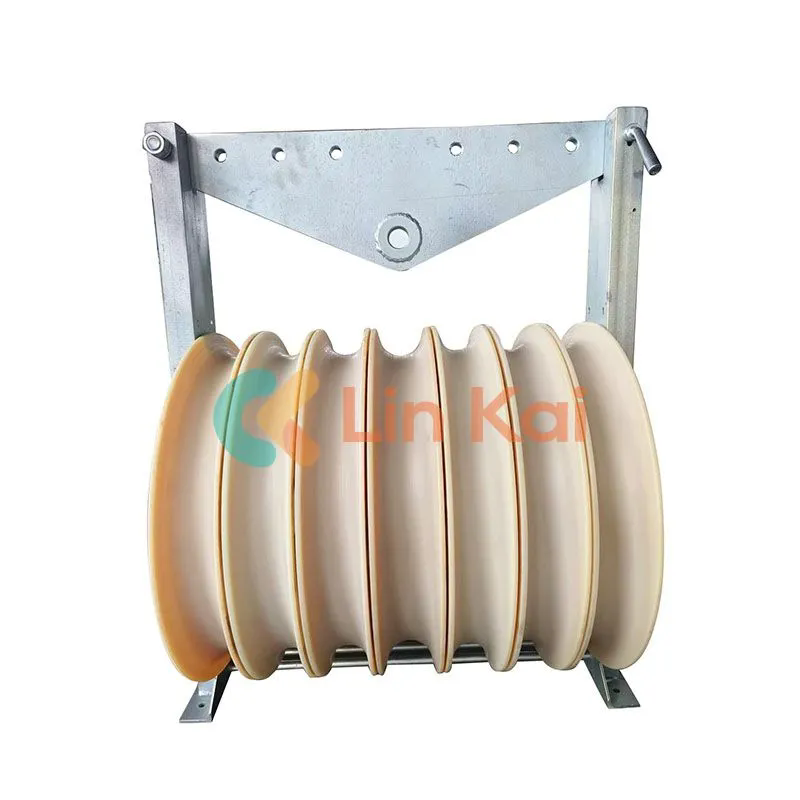What Are Conductor Pulley Stringing Blocks and Why Are They Essential in Power Line Construction?
2024-11-18
When it comes to the construction of power lines, conductor pulley stringing blocks play a crucial role in ensuring the process is efficient, safe, and effective. These specialized tools are used to guide the conductors (the cables carrying electrical current) through the transmission line towers, ensuring they are placed accurately and securely. But what exactly are these blocks, and why are they indispensable in power line stringing? Let’s dive in!
What Is a Conductor Pulley Stringing Block?
A conductor pulley stringing block is a piece of equipment used in the installation of power transmission lines. The blocks are typically attached to the top of transmission towers and are used to guide and support the conductors as they are pulled through the air. These blocks are designed to handle the weight of the conductors and withstand the tension applied during the stringing process.
Made from durable materials like aluminum, steel, or composite materials, conductor pulley stringing blocks are designed to minimize friction and prevent damage to the conductor during installation.
Why Are Conductor Pulley Stringing Blocks So Important?
1. Safe and Efficient Cable Placement
Stringing conductors involves pulling long, heavy cables across large distances, sometimes hundreds of meters high in the air. Conductor pulley stringing blocks ensure that these cables are placed precisely along the transmission towers without slipping or snagging. Their ability to guide the cables smoothly reduces the risk of accidents and equipment damage during installation.
2. Handling Heavy Loads
The conductors used in power lines are thick and heavy, requiring robust equipment to support their weight during the stringing process. Conductor pulley stringing blocks are built to handle significant amounts of weight, making them essential for ensuring the safe transportation of the conductors along the towers.
3. Minimizing Friction
As conductors are pulled through the air, friction can cause wear and tear on the cables. Conductor pulley stringing blocks are designed to reduce friction between the conductor and the pulley, which helps maintain the integrity of the cables and minimizes the risk of damage during installation.
4. Improving Stringing Speed and Accuracy
Efficient stringing blocks help increase the speed and accuracy of power line installation. With the ability to easily move conductors through the necessary towers, crews can complete the stringing process faster, reducing downtime and boosting productivity on the job site.
5. Versatility for Various Applications
Conductor pulley stringing blocks can be used in a wide range of power line projects, from small distribution lines to large-scale high-voltage transmission systems. Some blocks are designed for use on towers, while others are portable and can be mounted on different types of vehicles, allowing for greater flexibility during installation.
Types of Conductor Pulley Stringing Blocks
There are various types of conductor pulley stringing blocks designed for different applications and conditions. Here are a few examples:
1. Fixed Pulley Blocks
These are stationary blocks that are typically mounted on the transmission tower. They are used for simpler, smaller projects where the conductor’s path is more straightforward.
2. Swinging Pulley Blocks
Swinging blocks are mounted on pivot points and are designed to move with the conductor’s angle during the stringing process. They are ideal for projects that involve more complex cable routing or large towers.
3. Composite Pulley Blocks
Made from lightweight, durable composite materials, these blocks are corrosion-resistant and designed for use in harsh environments. They are perfect for areas where exposure to the elements may damage traditional metal pulleys.
4. Multiple Sheave Pulley Blocks
These blocks have multiple grooves or sheaves to accommodate several conductors at once, making them ideal for larger projects where multiple cables need to be strung simultaneously.
Where Are Conductor Pulley Stringing Blocks Used?
- High-Voltage Power Lines: Conductor pulley stringing blocks are essential in the construction of high-voltage transmission systems, which require the precise installation of large, heavy conductors across long distances.
- Overhead Power Lines: Whether for power distribution in urban areas or rural zones, stringing blocks are used to position the conductors along the towers safely.
- Substation Wiring: In substations, where power lines meet and switch, conductor pulley stringing blocks help position cables in an organized, secure manner.
- Emergency Repairs: During power outages or repairs, stringing blocks are often used to replace damaged conductors or add new lines efficiently.
Key Features to Look for in Conductor Pulley Stringing Blocks
- Load Capacity: Ensure the block can handle the weight and tension of the conductor, especially when working with larger cables.
- Durability: Choose blocks made from high-quality materials that can withstand harsh weather conditions, mechanical stress, and wear over time.
- Friction Reduction: Look for blocks with smooth grooves or bearing systems to minimize friction and prevent damage to the conductor.
- Ease of Use: Blocks should be easy to install, adjust, and operate, especially for large-scale projects requiring multiple blocks.
Conclusion
Conductor pulley stringing blocks are essential tools in the construction and maintenance of power lines. Their ability to support, guide, and protect conductors during installation ensures that power grids are built safely, efficiently, and accurately. Whether you're involved in high-voltage transmission, overhead lines, or maintenance projects, these blocks are a fundamental part of the process.
Are conductor pulley stringing blocks part of your toolkit for power line construction? Share your thoughts and experiences in the comments below!



